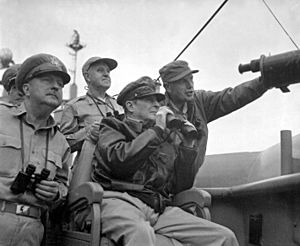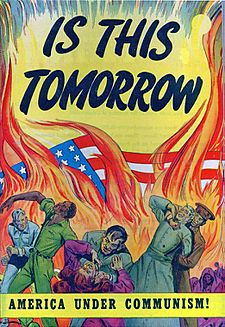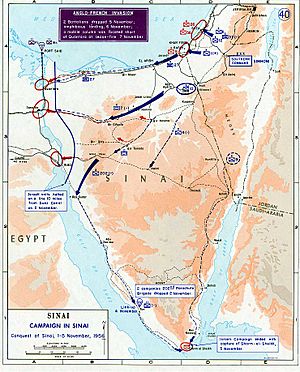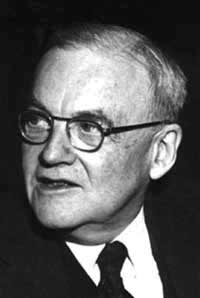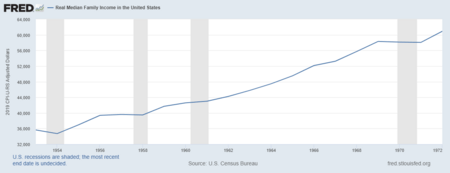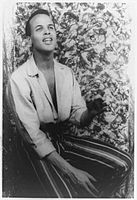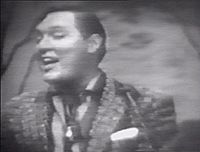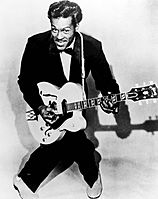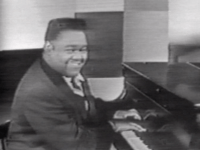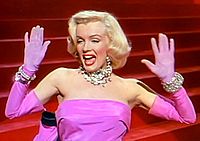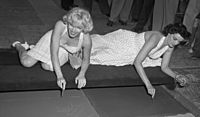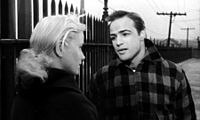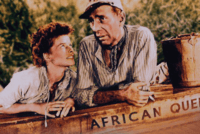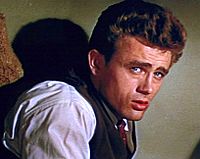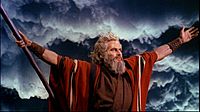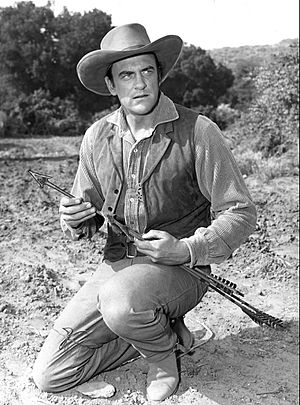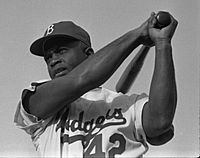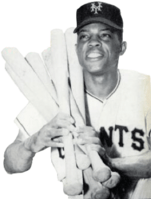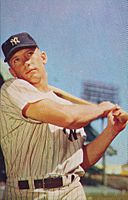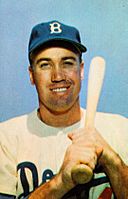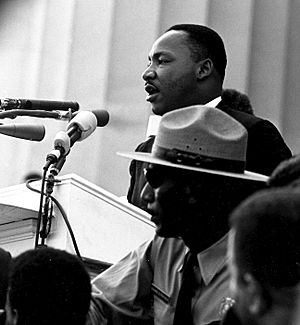History of the United States (1945–1964) facts for kids
| 1945–1964 | |
| Preceded by | History of the United States (1918–1945), World War II |
|---|---|
| Including | New Deal Era Early Cold War Second Great Migration |
| Followed by | History of the United States (1964–1980) |
The years 1945 to 1964 were a special time for the United States. The country saw a lot of economic growth and many people became more prosperous. It was also a time of big disagreements. The United States, a capitalist country, faced off against the Soviet Union and other communist states. This period of tension was called the Cold War.
At home, African Americans worked together to fight for their rights. The Civil Rights Movement successfully ended Jim Crow segregation in the Southern United States. New laws were passed to make discrimination illegal and to protect voting rights for everyone.
After World War II, the U.S. helped countries in Western Europe and Asia rebuild. The Marshall Plan was a big program that helped Western Europe recover. A main goal for America was to stop the spread of Communism, which the Soviet Union controlled. An arms race began, with both sides building more powerful nuclear weapons. The Soviets formed the Warsaw Pact to oppose the American-led North Atlantic Treaty Organization (NATO). The U.S. fought a difficult war in Korea. As this period ended, the U.S. was also getting more involved in the war in Vietnam. In 1962, the Cuban Missile Crisis happened when the USSR sent nuclear missiles to Cuba. This was the most dangerous moment of the era.
At home, the economy grew quickly after a short adjustment period. Most farmers moved to cities, and people had more money. Liberal Democrats like Harry S. Truman (1945–1953), John F. Kennedy (1961–1963), and Lyndon Johnson (1963–1969) led the country. Republican Dwight D. Eisenhower (1953–1961) was a moderate leader. He expanded Social Security and built the interstate highway system. After Kennedy's death in 1963, the Democrats launched the Great Society programs.
This time also saw the rise of suburbs and a growing middle class. People felt a strong sense of community.
Contents
The Cold War Begins
The Cold War (1945–1991) was a long period of political conflict and competition between the Soviet Union and its allied countries, and the Western world, led by the United States. Even though their armies never fought directly, they competed through military groups, spy activities, a nuclear arms race, and proxy wars (wars where bigger countries support opposing sides). They also competed in technology, like the space race.
How the Cold War Started
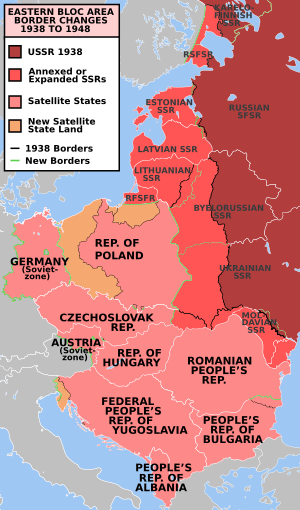
After World War II, President Truman was very suspicious of the Soviet leader, Stalin. The United States gave a lot of money to Western Europe through the Marshall Plan (1948-1951) to help them recover. The Soviet Union did not let its allied countries accept this help. Instead, the Soviets used their army and local Communist groups to control Eastern Europe.
In 1947, Britain could no longer support Greece in its fight against communists. So, the U.S. stepped in with the Truman Doctrine. This policy aimed to stop the spread of Soviet communism, an idea called containment. The U.S. believed that the Soviet system would eventually fail on its own.
By 1947, the Soviets controlled many countries in Eastern Europe, forming what was called the Iron Curtain. In Europe, the Cold War lines became clear, and there was no direct fighting. The United States helped create a strong military alliance called NATO in 1949.
In Asia, things were more active. The U.S. could not settle the conflict between its ally, nationalist China, and the Communists led by Mao Zedong. The Communists took over China in 1949. The U.S. then became the world's most powerful country, forming military alliances around the globe.
The U.S. believed in democracy and capitalism, while the Soviet Union believed in totalitarian communism. The U.S. hoped the new United Nations could solve problems, but it didn't always work.
Stopping Communism
The idea of "containment" became the main foreign policy for NATO. The hope was that the Soviet system would eventually collapse on its own, without a big "hot" war.
Events from 1949 to 1953
In 1949, Mao Zedong and the Communists won the civil war in China. China became a bitter enemy of the U.S. and signed a treaty with the Soviet Union. The U.S. then started spending a lot more on defense. The Soviets also built an atomic bomb in 1949, much sooner than expected. President Truman ordered the development of the hydrogen bomb. Two people were found guilty of sharing atomic secrets with Russia and were executed.
The U.S. also began funding France's efforts against Communist fighters in Vietnam.
The Korean War
In June 1950, North Korea invaded U.S.-supported South Korea. President Truman quickly sent American and UN forces to Korea to stop the invasion. This war became a proxy war between the United States and its allies, and Communist China and the Soviet Union.
After some early retreats, General Douglas MacArthur led a surprise landing at Inchon. The North Korean army fell apart, and MacArthur's forces pushed north. But then, hundreds of thousands of Chinese soldiers entered the war. They pushed the U.S. and UN forces back to the original border.
MacArthur wanted to invade China, but President Truman disagreed. Truman wanted a limited war, so he removed MacArthur from his command. Dwight D. Eisenhower promised to end the war when he ran for president in 1952. He ended the war in 1953 by threatening to use nuclear weapons.
An agreement was signed on July 27, 1953. The war resulted in many deaths and injuries for American, Korean, and Chinese soldiers.
Fighting Communism at Home: McCarthyism
In 1947, Congress passed the Taft-Hartley Act to balance the rights of workers and businesses. It also aimed to remove Communist leaders from labor unions. Many liberals worked to remove Communists from unions and the Democratic Party.
The House Un-American Activities Committee, with Richard Nixon playing a key role, accused a former Roosevelt aide, Alger Hiss, of being a Communist spy. Hiss was convicted, which gave anti-Communists a strong political tool. This helped Nixon rise in politics.
In 1950, Senator Joseph McCarthy from Wisconsin started investigations into supposed spies in the government. McCarthy used strong accusations and tactics. He claimed there had been "twenty years of treason" in the government. When he attacked the Army in 1953, President Eisenhower encouraged Republicans to formally criticize McCarthy in 1954. McCarthy's power quickly ended.
"McCarthyism" also included attacks on people in Hollywood. Artists who refused to answer questions about Communist ties were put on a Hollywood blacklist and could not find work. Some famous people left the U.S. Others used fake names. McCarthyism caused a lot of fear and debate in the United States. It led to blacklists in many industries.
Suez Canal Conflict
The Suez Crisis was a war over control of the Suez Canal in 1956. Egypt's leader, Gamal Abdel Nasser, took control of the canal. The United Kingdom, France, and Israel invaded to get it back. The U.S. had warned against military action. The invasion was a military success, but the canal was blocked. President Eisenhower demanded that the invaders leave, and they did. This event was a big embarrassment for Britain and France. It showed that European countries were losing their global power. The United States then became much more involved in Middle Eastern politics.
Eisenhower and Kennedy Years
After Stalin died in 1953, President Dwight D. Eisenhower ended the Korean War. He continued Cold War policies. Secretary of State John Foster Dulles was a key figure in foreign policy. He talked about "massive retaliation," meaning the U.S. would use its powerful nuclear weapons if needed. He called this "brinkmanship," pushing situations to the edge of war.
In 1957, the Soviets launched Sputnik, the first satellite in space. This shocked Americans, who thought they were technologically superior. The space race began. By the early 1960s, the U.S. was ahead, and President Kennedy promised to land a man on the moon by the end of the decade. This happened on July 20, 1969.
Trouble came close to home when Fidel Castro took control of Cuba in 1959. He became close with the Soviet Union. The U.S. responded with an economic boycott of Cuba and aid programs for Latin America.
In 1961, the Soviets built the Berlin Wall to stop East Germans from fleeing communism. This was a propaganda setback for the USSR.
The Communist world split when China turned against the Soviet Union. The U.S. did not take advantage of this split until later. In 1958, the U.S. sent troops to Lebanon to help stabilize the country. Eisenhower also sent aid and military advisers to South Vietnam.
The Cold War became most dangerous during the Kennedy administration with the Cuban Missile Crisis in October 1962. This was a tense standoff over Soviet nuclear missiles in Cuba. Kennedy decided not to invade Cuba but to blockade the island. The crisis ended with a compromise: the Soviets removed their missiles, and the U.S. secretly removed its missiles from Turkey.
The Americas
In the 1950s, Latin America saw many conflicts between the Soviet Union and the United States. The U.S. Central Intelligence Agency helped overthrow the Guatemalan government in 1952.
In 1959, Fidel Castro took over Cuba, creating the first communist government in the Western Hemisphere. He later turned to the Soviet Union for help.
Life in America
The 1950s saw a huge demand for consumer goods. This was because of the prosperity after the war. People had saved money during the war and now wanted to spend it. They bought new homes, cars, and household items. Wages were rising, and more people enjoyed comforts like vacuum cleaners and washing machines. Many new inventions appeared during this time.
The Economy
After the war, the economy had a difficult start. Many returning soldiers needed jobs, and there were shortages of goods. Prices rose a lot until 1950. But after 1948, the economy grew very fast for the next 23 years. Between 1945 and 1960, the country's total production grew by 250%. Spending on new buildings increased nine times. By 1960, the average income per person was 35% higher than in 1945.
By the mid-1950s, 60% of Americans were considered "middle-class." By 1960, 87% of families owned a TV, 75% owned a car, and 75% owned a washing machine. The average income for American workers grew a lot.
This prosperity made Americans feel it was a good time to have children, leading to a huge baby boom after 1945. This meant a big demand for children's products and a large expansion of schools.
The U.S. also became "the world's factory" because its land was not damaged by the war. American money and goods helped rebuild Europe, South Korea, and Japan.
The American economy grew at 3.5% per year between 1945 and 1970. Many people's incomes doubled in one generation. Factory jobs paid well and helped many workers join the middle class. By the end of the 1950s, blue-collar workers were buying many luxury goods.
Most American workers with stable jobs were financially well-off. Even non-union jobs offered rising pay and benefits. Workers could afford homes, new cars, and regular vacations.
Despite this prosperity, economic growth was slower during Eisenhower's time. Federal income taxes were very high. There were also three economic downturns. President Kennedy later proposed reducing taxes, which helped the economy grow even faster after his death.
Cars
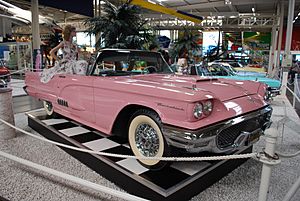
Cars became much more available after the war. Car styles became flashier, with tail fins and bright colors in the late 1950s. Smaller car makers struggled to compete. Ford's new Edsel car, launched in 1958, was a big failure.
The Rise of Suburbs
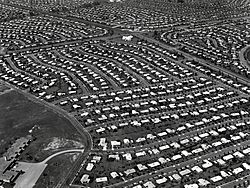
During the Great Depression and World War II, very few new homes were built. Many people lived in crowded apartments. The growth of suburbs depended on cars, highways, and affordable housing. Many people had saved money and could now afford down payments. The G.I. Bill helped veterans get low-cost home loans.
Developers bought empty land outside cities and built many similar houses quickly. The most famous development was Levittown on Long Island. It offered new homes for a low down payment and monthly cost. Suburbs grew especially fast in the Sun Belt. Along with suburbs came shopping malls, fast-food restaurants, and coffee shops.
By 1960, one-third of the nation's population lived in suburbs. This growth was due to prosperity, low-interest mortgages, and the baby boom. Suburbs offered bigger homes, privacy, and space for new consumer goods.
Science, Technology, and the Future
With the prosperity of the era, people believed strongly in science, technology, and progress. There was a desire for everything to be new and more advanced.
The war led to a technology boom. Factories could now produce consumer goods in large amounts and with more advanced features. Luxury cars became more affordable for the upper middle class.
These changes also led to bigger companies and fewer small businesses. Newspapers declined as TV news became popular. The railroad industry also declined as car sales and highways grew. Suburbanization caused jobs and people to move out of inner cities, which later had negative effects on urban areas.
Major scientific and technological events included:
- The Miller–Urey experiment in 1953 showed how basic building blocks of life could form.
- The structure of DNA was discovered in 1953.
- The first polio vaccine was introduced in 1955.
- The first organ transplants were done in 1954.
- The term artificial intelligence was created in 1956.
- Sputnik 1 was launched in 1957, starting the space race.
- NASA was organized.
Poverty and Inequality
Despite the overall prosperity, many Americans still lived in poverty. In 1947, 34% of families earned less than $3,000 a year. Older Americans often struggled financially, especially if they had lost savings during the Great Depression. Many blue-collar workers still lived in poverty.
There was also a big difference in income between white and black families. In 1947, 60% of black families lived below the poverty line, compared to 23% of white families. By 1968, these numbers improved but differences remained.
Poverty decreased a lot in the 1960s, especially for older people. The number of people below the poverty line almost halved from 22% in 1960 to 12% in 1970.
Rural Life
The number of people living on farms steadily decreased as families moved to cities for better jobs and living standards. Farming became more mechanized, using new fertilizers and hybrid corn. This meant farmers could work more land with less help. Many sold their land and moved to towns. Factories also moved to rural areas for cheaper land and lower taxes. Remote rural areas became popular for retirees and vacationers.
Culture
Key Cultural Events
- Television became hugely popular. By the end of the decade, 77% of U.S. homes had a TV.
- Social rules were strict, with a focus on fitting in.
- The movie The Day the Earth Stood Still started a trend of Hollywood films about alien invasions, reflecting Cold War fears.
- There was a rise in evangelical Christianity.
- Disneyland opened in July 1955.
Fine Arts
Abstract expressionism, an American art movement, became very influential worldwide. It made New York City a major art center. Jackson Pollock was a famous painter in this movement. Later, other abstract styles like Color Field painting became popular.
Literature
The strict social rules of the time also affected literature. Many writers felt they had to censor themselves. But the Beat Generation writers pushed boundaries, which had an exciting effect on culture. Their works, like William S. Burroughs' Naked Lunch and Jack Kerouac's On the Road, were sometimes censored.
This decade also saw many famous science fiction books by writers like Isaac Asimov and Ray Bradbury.
Later books like The Feminine Mystique by Betty Friedan (published in 1963) criticized the role of housewives in the postwar years. This book helped start the women's liberation movement.
Fashion
Fashion changed a lot in the 1950s. Early in the decade, fitted blouses and jackets were popular. Narrow pants and capris were worn with flats. Circle skirts, like the classic poodle skirt, were very popular and often decorated.
As the decade went on, A-line dresses and loose-fitting styles became popular. Kitten heels and steel stilettos were the most popular shoes. Large hairstyles were also in style.
Prosperity also led to the first distinct youth culture. Teenagers had more freedom and money. New music like rock-and-roll emerged, along with new fashion styles and subcultures. The "greaser" was a famous example, known for motorcycles and ducktail haircuts. Movies like The Wild One and Rebel Without A Cause influenced this trend.
Music
Popular music and Country music in the early 1950s featured singers like Frank Sinatra and Patti Page. Jazz stars like Miles Davis and John Coltrane also became famous.
Rock-n-Roll and Electric blues became popular with teens in the mid-1950s. Famous artists included Chuck Berry, Fats Domino, and Little Richard. Elvis Presley was the biggest music superstar, known for rock, rockabilly, and ballads. Doo-wop was another popular genre.
-
Harry Belafonte, 1954
-
Bill Haley singing Rock Around the Clock, 1955
-
Chuck Berry in 1957
-
Fats Domino singing Blueberry Hill in 1956
Theater
Musicals were very popular on Broadway. Many Rodgers and Hammerstein shows like Oklahoma! and The Sound of Music were hits. Other popular musicals included Guys and Dolls and West Side Story.
Important dramas of the decade included The Crucible by Arthur Miller and Cat on a Hot Tin Roof by Tennessee Williams.
Cinema
With TV becoming popular, fewer people went to movies. Hollywood tried new film techniques like Cinemascope and 3-D film to attract audiences. Big historical movies like The Ten Commandments and Ben-Hur were made.
Science fiction films were also popular, often reflecting Cold War fears. Movies like Invasion of the Body Snatchers and The Day the Earth Stood Still showed aliens as metaphors for foreign threats. Japanese films like Godzilla also became famous.
Teen films started with The Wild One starring Marlon Brando. Blackboard Jungle featured Rock Around the Clock and is seen as a spark for the rock and roll revolution.
Musicals remained popular in film, with adaptations of Broadway shows like Oklahoma! and Singin' in the Rain.
The Walt Disney Studios had a prosperous decade with animated films like Cinderella and Sleeping Beauty. They also made live-action films like Davy Crockett, King of the Wild Frontier and Old Yeller.
Famous stars appeared in classic films like Sunset Boulevard with Gloria Swanson and Some Like It Hot with Marilyn Monroe. Actors like Marlon Brando and James Dean influenced acting styles.
-
Elizabeth Taylor in Father of the Bride, 1950
-
Marilyn Monroe in Gentlemen Prefer Blondes, 1953
-
Marilyn Monroe and Jane Russell at Grauman's Chinese Theater, 1953
-
Montgomery Clift in I Confess, 1953
-
Marlon Brando with Eva Marie Saint in On the Waterfront, 1954
-
Humphrey Bogart and Katharine Hepburn in The African Queen, 1951
-
James Dean in East of Eden, 1955
-
Charlton Heston in The Ten Commandments, 1956
Comics
Comic books became more popular after World War II. Charles M. Schulz's Peanuts comic strip first appeared in 1950. Humor strips made a comeback. Superhero comics were less popular than before, but romance comics, horror comics, western comics, and science fiction comics were in demand.
Horror comics became very popular but faced strong public disapproval. In 1954, Senate hearings looked into graphic crime and horror comics. Because of this, the comic book industry created the Comics Code Authority (CCA) to self-regulate content. Many comic series were changed or canceled.
Superhero comics were still around, with titles like Superman and Batman. Satire and humor comics were also popular, especially MAD, which started in 1952 and became very influential.
Television
Television sets became common in most American homes by the mid-to-late 1950s. TV also became a major way to advertise products.
Popular TV shows included Your Show of Shows, a comedy series, and Producers' Showcase, which featured famous actors.
Toys
Popular toys included Wham-O's Hula Hoop and Frisbee, both introduced in 1957. Kids rode Schwinn bicycles and Radio Flyer wagons. Robot toys were popular. Girls liked tin tea sets and Barbie dolls, first made in 1959. Boys wanted BB guns and miniature cars. Mr. Potato Head was the first toy advertised on TV. Board games like Candy Land and Chutes and Ladders were bestsellers.
Notable Sports Figures
-
Jackie Robinson, 1954
-
Willie Mays, 1954
-
Mickey Mantle, 1953
-
Duke Snider, 1953
- Hank Aaron (baseball)
- Yogi Berra (baseball)
- Jim Brown (football)
- Roberto Clemente (baseball)
- Bob Cousy (basketball)
- Joe DiMaggio (baseball)
- Mickey Mantle (baseball)
- Rocky Marciano (boxing)
- Willie Mays (baseball)
- Jackie Robinson (baseball)
- Sugar Ray Robinson (boxing)
- Bill Russell (basketball)
- Ted Williams (baseball)
The Civil Rights Movement
After the Reconstruction era, many states passed Jim Crow laws that kept races separate and treated African Americans as second-class citizens. The Supreme Court had allowed segregation in 1896. It was hard for African Americans to vote in the South.
The Civil Rights Act of 1957 was the first federal civil rights law in almost a century. It helped prepare the way for the important Civil Rights Act of 1964.
Brown v. Board of Education and Resistance
In the early days of the Civil Rights Movement, people tried to end segregation through lawsuits. A major change happened with the U.S. Supreme Court's decision in Brown v. Board of Education (1954). This ruling made segregated public schools illegal. The Court said that "separate but equal" schools could never truly be equal for black Americans. Many Southern politicians signed "The Southern Manifesto" to oppose this decision.
Some governors, like Orval Faubus of Arkansas, used the National Guard to stop school integration in 1957. President Eisenhower sent in the U.S. Army to enforce the court orders. Other governors also tried to block integration. Police sometimes used violence against peaceful civil rights protesters.
Civil Rights Groups
The Civil Rights Movement was led and organized by African Americans. They bravely put themselves and their families on the front lines. Their peaceful protests were often met with violence from law enforcement, which was shown on TV and in newspapers. This helped Americans understand the struggle.
The movement was not led by just one or two people. It was a widespread effort that fought segregation in many places using different methods. While some groups supported Black Power or armed resistance, most remained committed to nonviolence. They used nonviolent strategies to get national attention.
Black churches played a key role. They offered a place for people to lead and organize. Martin Luther King Jr. was the most famous leader. He worked tirelessly for black freedom and won the 1964 Nobel Peace Prize.
Students and religious leaders also played important roles. Groups like the Southern Christian Leadership Conference (SCLC) and the Student Nonviolent Coordinating Committee (SNCC) organized protests and voter registration drives. These new groups often worked with older organizations like the National Association for the Advancement of Colored People (NAACP) and the Congress of Racial Equality (CORE). The NAACP provided legal help for jailed protesters. CORE organized the 1961 Freedom Rides.
President John F. Kennedy and Attorney General Robert F. Kennedy supported desegregation and voting rights. However, FBI director J. Edgar Hoover tried to discredit King and other civil rights leaders.
Presidential Leaders
Harry S. Truman: 1945–1953
President Truman was a down-to-earth leader from Missouri. He was different from the previous president, Roosevelt. Truman relied on his cabinet and famously said, "The buck stops here."
Truman faced many challenges at home. After the war, there were shortages of housing and goods. Strikes happened in major industries. In 1946, Republicans took control of Congress. Truman used executive orders to end racial discrimination in the military.
In foreign affairs, Truman oversaw the defeat of Nazi Germany and the decision to use nuclear weapons against Japan. He helped create the United Nations and launched the Marshall Plan to rebuild Europe. He also started the Truman Doctrine to contain communism, leading to the Cold War. Key events included the Berlin Airlift and the creation of NATO. He also led the U.S. in the Korean War.
Truman surprised everyone by winning the 1948 election. His victory showed support for his domestic policies, foreign policy of containment, and commitment to civil rights.
The Kefauver hearings (1950-1951) investigated organized crime and corruption across the country. They captured America's attention.
The defeat of America's ally in the Chinese Civil War led to a hostile Communist government in China. Soon, the U.S. was fighting China in the Korean War. Corruption in Truman's administration became an issue in the 1952 election. Truman did not run for a third term. Republican Dwight D. Eisenhower won the 1952 election by campaigning against Truman's problems with "Communism, Korea, and Corruption."
Dwight D. Eisenhower: 1953–1961
Eisenhower was a famous wartime general. He became president in 1953. He ended the Korean War and kept peace in Asia and the Middle East. He worked well with NATO allies and continued the policy of containing Communism.
The economy was generally good, except for a downturn in 1958. Eisenhower remained popular and was reelected in 1956. He expanded Social Security and did not try to undo the remaining New Deal programs.
In 1956, the U.S. federal government approved the Interstate Highway Act. This system of highways greatly improved transportation. It made suburban growth possible and boosted tourism. While it had some negative impacts on cities, it was a big success.
Eisenhower got along well with the Democrats, who controlled Congress for most of his presidency. In his farewell speech, he warned about the dangers of a growing "military–industrial complex."
John F. Kennedy: 1961-1963
1960 Presidential Election
The 1960 election was very close. Republican Vice President Richard Nixon ran against Democratic Senator John F. Kennedy. Kennedy won due to an economic downturn, more registered Democrats, and his strong campaign. Kennedy was the first Catholic president. His election showed that Catholics were accepted in America.
Presidency
Kennedy was a young and energetic leader. He focused on new, strong policies in foreign affairs. He famously asked Americans to "ask not what your country can do for you - ask what you can do for your country." In Congress, a group of conservatives blocked most of Kennedy's domestic programs. However, the civil rights movement gained strength during his time.
Assassination
President Kennedy was assassinated in Dallas, Texas, on November 22, 1963, by Lee Harvey Oswald. This event was a huge shock to the American people. Kennedy became seen as a hero.
Lyndon B. Johnson: 1963–1969
After Kennedy's death, Vice President Lyndon B. Johnson became president. He used his power to pass many liberal laws that he called the Great Society. Johnson pushed hard to pass the Civil Rights Act of 1964. These actions helped Johnson win a huge victory in the 1964 presidential election. His win brought a large liberal majority to Congress.
Images for kids
See also
 In Spanish: Historia de Estados Unidos (1945-64) para niños
In Spanish: Historia de Estados Unidos (1945-64) para niños


